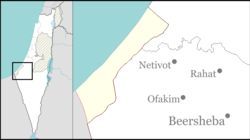
Re'im

Re'im
רֵעִים | |
|---|---|
 The dining room was designed by Hanan Havron, a kibbutz member | |
| Etymology: Friends | |
| Coordinates: 31°23′10″N 34°27′37″E / 31.38611°N 34.46028°E | |
| Country | Israel |
| District | Southern |
| Council | Eshkol |
| Affiliation | Kibbutz Movement |
| Founded | 1949 |
| Founded by | Scouts Federation and former Palmach members |
| Population (2022)[1] | 422 |
| Website | www.reim.org.il |
Re'im (Hebrew: רֵעִים, lit. 'Friends') is a secular kibbutz in southern Israel, and one of the Gaza vicinity villages. Located at the confluence of Besor Stream and Gerar Stream in the north-western Negev desert, it falls under the jurisdiction of Eshkol Regional Council. In 2022, it had a population of 422.[1]

Re'im was founded in 1949 by members of the Israel Boy and Girl Scouts Federation who were demobilized from the Palmach. The kibbutz was designed by the architect Hanan Havron. The building, which was used by the Havron for decades as his office, is today the kibbutz's heritage building, with a display of the history of the place.[2]

An outdoor music festival near Re'im was attacked by Hamas on 7 October 2023, as part of a larger invasion of Israel. Several hundred people were killed and many bodies and cars were set on fire.

Geography
Re'im is located between roads 232 and 234 in the western Negev, next to the Re'im Junction and Gama Junction. The ruins of ancient Gama (Tell Jemmeh) are located to the west of the kibbutz. West of Re'im is the kibbutz Kissufim, and north is Be'eri.[3] Re'im's elevation is 50 m (160 ft) above sea level, and the Besor Stream passes through its territory.[4]

History
The kibbutz was established in 1949 by former Palmach members with the provisional name HaTzofim Vav (lit. 'Scouts F').[4] It was then named Tel Re'im (Hebrew: תל רעים, lit. 'Hill of Friends') after the Arabic translation of the nearby archaeological site of Tell Jemmeh. It was eventually renamed Re'im in memory of members of the Gar'in who were killed in the 1948 Arab–Israeli War.[5] The name, meaning 'friends', was taken from the Book of Proverbs (18:24) to symbolize them.[6]

The kibbutz was planned by the architect Hanan Habaron, one of the founders of the kibbutz and a member until his death in 2002. The ascetic style was described as a visual expression of Habaron's social and architectural worldviews. Asaf Kashtan, an Israeli architect who wrote a book about Habaron, said that in recent years, Habaron's style fell out of favor with Re'im's residents.[7]

The Israel Defense Forces (IDF) has a base near the kibbutz. Prior to the Israeli disengagement from Gaza in 2005, the base was used as a camp for the evacuating troops. [citation needed] After the disengagement, Re'im became the target of Qassam rockets fired at it from the Gaza Strip.[8] In 2008 IDF troops at the nearby base close to Nahal Oz requested that the base be relocated to the area near Re'im, away from the range of Hamas' mortar fire.[9]

On 7 October 2023 Re'im was attacked by Hamas during the battle of Re'im. Dozens of Israeli casualties were reported from the area.[10] On the same day, a music festival was taking place on the kibbutz grounds. Hamas overran the event, indiscriminately shooting into the crowd, leaving hundreds dead, with many others wounded or taken hostage.[11] In the aftermath, the kibbutz's surviving residents were evacuated to Eilat, before being relocated to Tel Aviv.[12]

Economy
As of 2008, the kibbutz's economy was based on agriculture and its laser factory, Isralaser.[13] IsraBig, which manufactures dies for stamping, also has a factory in Re'im.[citation needed] The kibbutz also has a room letting business, including a Bedouin accommodation tent.[14][15] It suffered as a result of the Israel–Gaza conflict, and the kibbutz lowered its prices sometime around 2008.[when?][8]

In 2008, Re'im embarked on a project that was planned make it the first community in Israel, and perhaps in the entire world, to rely entirely on solar energy for domestic consumption. Sunday, a company which marketed the technology in Israel, was to install solar panels on all 130 rooftops in the kibbutz. The cost of the project was estimated at ₪60–100 million and the investment was expected to pay for itself in 10 years. The cost and revenues from electricity were to be divided evenly between the kibbutz and Sunday, and any excess energy was to be sold to the Israel Electric Company.[16][needs update]

Being one of the Gaza-vicinity villages, as of 2022, its residents are given an income tax benefit in accordance with Article 11 of the Income Tax Ordinance.[17]

Security
Re'im is eligible for support in building fortified residential shelters, Merkhav Mugan Dirati, available for localities situated within a 7-kilometer radius from the Gaza Strip.

In June 2015, the construction of these residential shelters within individual family homes was completed. Given kibbutz Re'im's geographic proximity to Gaza, when a Red Color alarm is triggered, residents are required to promptly find shelter within a window of 8-15 seconds.[18]

Archaeology

Tell Jemmeh is a prominent 23 meter high mound located near Re'im. Archaeologists identify Tel Jemmeh with the Canaanite royal city of Yursa mentioned in the records of Thutmose III Pharaoh of Egypt who describes the city as the southernmost of the Canaanite cities that rebelled against Egypt.[19][20]

During the period of the Amarna letters, a Canaanite governor named Pu-Ba'lu, who corresponded with Akhenaten, ruled the city.[21]

Yursa is mentioned again in the inscription of Esarhaddon, King of Assyria, in which it is mentioned as one of the cities that rebelled against the Assyrian kingdom and as a result it was conquered and its queen was exiled to Nineveh.

Around a kilometre north to Re'im are remains that have been identified tentatively with those of the village of Kefar She'arta.[22] These remains include an ancient building, a round cistern and fragments of pottery and glass from the Byzantine period. Yizhar Hirschfeld suggests that the building could have been the monastery of Zeno the Prophet, a 5th century hermit.[23]

See also
References
- ^ a b "Regional Statistics". Israel Central Bureau of Statistics. Retrieved 21 March 2024.
- ^ Zandberg, Esther (8 May 2003). "השאיר אחריו קיבוץ למזכרת" [He left behind a kibbutz as a memorial]. Haaretz (in Hebrew). Retrieved 13 October 2023.
- ^ Gold Atlas (Map) (2009 ed.). 1:100,000 (in Hebrew). Mapa. p. 48. ISBN 965-521-082-0.
- ^ a b Vilnai, Ze'ev (1980). "Re'im". Ariel Encyclopedia (in Hebrew). Vol. 8. Tel Aviv, Israel: Am Oved. p. 7607.
- ^ El'azari, Yuval, ed. (2005). Mapa's concise gazetteer of Israel (in Hebrew). Tel-Aviv: Mapa Publishing. p. 584. ISBN 965-7184-34-7.
- ^ HaReuveni, Immanuel (1999). Lexicon of the Land of Israel (in Hebrew). Miskal - Yedioth Ahronoth Books and Chemed Books. p. 887. ISBN 965-448-413-7.
- ^ Zandberg, Esther (8 May 2003). השאיר אחריו קיבוץ למזכרת [He left behind a kibbutz]. Haaretz (in Hebrew). Retrieved 14 August 2014.
- ^ a b Branovsky, Yael (29 July 2006). עורף חזק [Strong home front]. nana10 (in Hebrew). Archived from the original on 24 May 2011. Retrieved 24 December 2008.
- ^ Harel, Amos (30 November 2008). "IDF soldiers: We tried to no avail to have base near Nahal Oz relocated". Haaretz. Retrieved 14 August 2014.
- ^ "Report: Bodies being removed, identified from site of large party near Re'im". Times of Israel. 7 October 2023. Archived from the original on 8 October 2023. Retrieved 7 October 2023.
- ^ Murphy, Paul P; Goodwin, Allegra; Brown, Benjamin; Paget, Sharif (9 October 2023). "Desert horror: Music festival goers heard rockets, then Gaza militants fired on them and took hostages". CNN. Retrieved 9 October 2023.
- ^ ניסני, יובל (15 November 2023). "רעים יעברו לת"א, בארי מתלבטים: החיים הזמניים של המפונים מהעוטף". Globes.
- ^ "Isralaser retools with $1 M laser project. (Isralaser-Reim, acquires laser machine)". Israel Business Today. 18 March 1994. Archived from the original on 22 October 2012. Retrieved 24 December 2008.
- ^ "Host kibbutzim in the Negev". Zimmer. Archived from the original on 8 April 2009. Retrieved 15 August 2014.
- ^ "Kibbutz Re'im Information". Or Movement. Archived from the original on 3 March 2016. Retrieved 24 December 2008.
- ^ Ben-David, Amir (22 December 2008). "The first solar kibbutz". Ynetnews. Archived from the original on 23 December 2008. Retrieved 24 December 2008.
- ^ "Guidelines for the implementation of the tax benefit for residents of the Gaza envelope have been issued". Israel Tax Authority. 10 February 2022.
- ^ "How Much Time to Reach the Protected Space?". National Emergency POrtal.
- ^ Gus w. van Beek, Digging up Tell Jemmeh, Archaeology, Vol. 31, No. 1, January/February 1983, Archaeological Institute of America pp.12–19
- ^ Van Beek, G.W., "Tell Gamma", IEJ 27, pp. 171–176, 1977
- ^ Ben-Shlomo, David; van Beek, Gus, eds. (2014). The Smithsonian Institution Excavation at Tell Jemmeh, 1970–1990. Smithsonian Institution Scholarly Press.
- ^ "Khirbet Se'arta; Ḥorvat Seorah - ZENO". dig.corps-cmhl.huji.ac.il. The Hebrew University of Jerusalem. Retrieved 5 February 2024.
- ^ Bitton-Ashkelony, Brouria; Kofsky, Arieh (1 January 2004). Christian Gaza In Late Antiquity. BRILL. pp. 72–73. ISBN 978-90-04-13868-1. Retrieved 5 February 2024.
External links
- Official website (in Hebrew)
See what we do next...
OR
By submitting your email or phone number, you're giving mschf permission to send you email and/or recurring marketing texts. Data rates may apply. Text stop to cancel, help for help.
Success: You're subscribed now !


